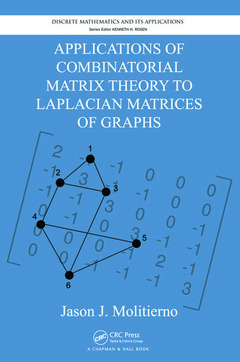Description
Applications of Combinatorial Matrix Theory to Laplacian Matrices of Graphs
Discrete Mathematics and Its Applications Series
Author: Molitierno Jason J.
Language: English
Subjects for Applications of Combinatorial Matrix Theory to Laplacian...:
Keywords
Laplacian Matrix; Algebraic Connectivity; Matrix Theory Preliminaries; Pendant Vertex; Graph Theory Preliminaries; Laplacian Matrices; Introduction To Laplacian Matrices; Cut Vertex; The Algebraic Connectivity; Characteristic Vertex; The Group Inverse Of The Laplacian Matrix; Group Inverse; Connected Graph; Nonadjacent Vertices; Fiedler Vector; Perron Vector; Degree Sequence; Matrix Tree Theorem; Bethe Tree; Unweighted Graph; Planar Graph; Weighted Graph; Simple Eigenvalue; Nonnegative Matrices; Unicyclic Graphs; Maximal Planar Graph; Noncomplete Graph; Incidence Matrix; Unweighted Tree; Moore Penrose Inverse
426 p. · 17.8x25.4 cm · Paperback
Description
/li>Contents
/li>Readership
/li>Biography
/li>
On the surface, matrix theory and graph theory seem like very different branches of mathematics. However, adjacency, Laplacian, and incidence matrices are commonly used to represent graphs, and many properties of matrices can give us useful information about the structure of graphs.
Applications of Combinatorial Matrix Theory to Laplacian Matrices of Graphs is a compilation of many of the exciting results concerning Laplacian matrices developed since the mid 1970s by well-known mathematicians such as Fallat, Fiedler, Grone, Kirkland, Merris, Mohar, Neumann, Shader, Sunder, and more. The text is complemented by many examples and detailed calculations, and sections followed by exercises to aid the reader in gaining a deeper understanding of the material. Although some exercises are routine, others require a more in-depth analysis of the theorems and ask the reader to prove those that go beyond what was presented in the section.
Matrix-graph theory is a fascinating subject that ties together two seemingly unrelated branches of mathematics. Because it makes use of both the combinatorial properties and the numerical properties of a matrix, this area of mathematics is fertile ground for research at the undergraduate, graduate, and professional levels. This book can serve as exploratory literature for the undergraduate student who is just learning how to do mathematical research, a useful "start-up" book for the graduate student beginning research in matrix-graph theory, and a convenient reference for the more experienced researcher.
Matrix Theory Preliminaries. Graph Theory Preliminaries. Introduction to Laplacian Matrices. Algebraic Connectivity. The Fiedler Vector and Bottleneck Matrices for Trees. Bottleneck Matrices for Graphs. The Group Inverse of the Laplacian Matrix.




